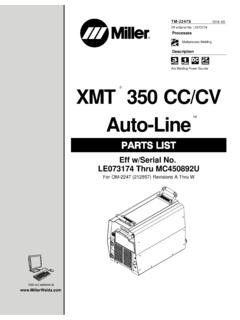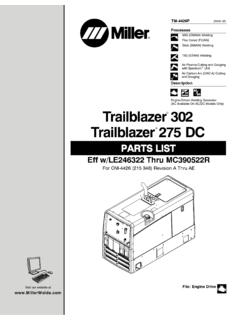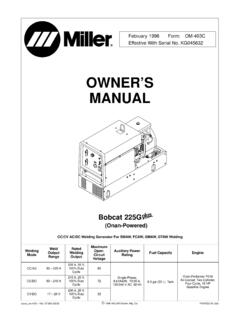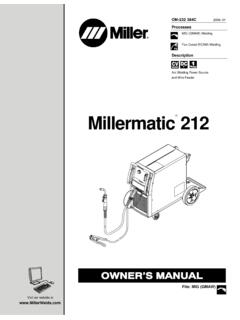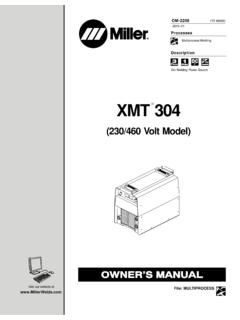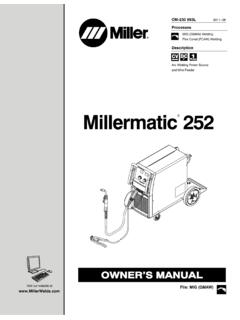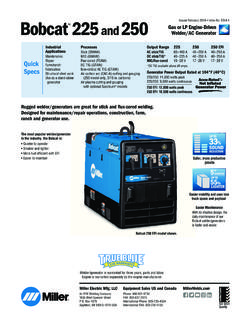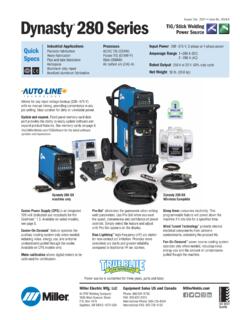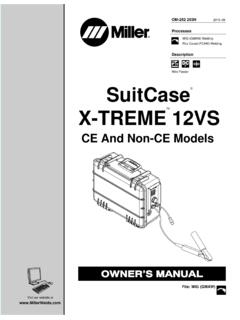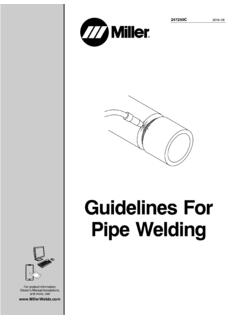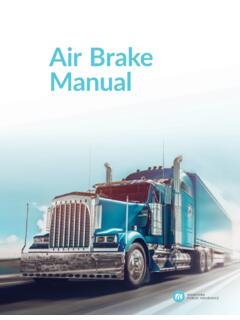Transcription of Syncrowave 180 SD - Miller
1 OM-360207 220 AOctober 2002 ProcessesDescriptionTIG (GTAW) WeldingStick (SMAW) WeldingArc Welding Power SourceSyncrowave 180 SDRV isit our website Electric manufactures a full lineof welders and welding related information on other quality Millerproducts, contact your local Miller distributor to receive the latest fullline catalog orindividual catalog sheets. To locate your nearestdistributor or service agency call 1-800-4-A- Miller , or visit us on the you and congratulations on choosing Miller . Now you can getthe job done and get it done right. We know you don t have time to doit any other s why when Niels Miller first started building arc welders in 1929,he made sure his products offered long-lasting value and superiorquality. Like you, his customers couldn t afford anything less. Millerproducts had to be more than the best they could be.
2 They had to be thebest you could , the people that build and sell Miller products continue thetradition. They re just as committed to providing equipment and servicethat meets the high standards of quality and value established in Owner s Manual is designed to help you get the most out of yourMiller products. Please take time to read the Safety precautions. Theywill help you protect yourself against potential hazards on the ve made installation and operation quickand easy. With Miller you can count on yearsof reliable service with proper if for some reason the unit needs repair,there s a Troubleshooting section that willhelp you figure out what the problem is. Theparts list will then help you to decide theexact part you may need to fix the and service information for yourparticular model are also is the first weldingequipment manufacturer inthe to be registered tothe ISO 9001:2000 QualitySystem as hard as you do every power source fromMiller is backed by the mosthassle-free warranty in Miller to YouMiller offers a TechnicalManual which providesmore detailed service andparts information for yourunit.
3 To obtain a TechnicalManual, contact your localdistributor. Your distributorcan also supply you withWelding Process Manualssuch as SMAW, GTAW,GMAW, and OF CONTENTSSECTION 1 SAFETY PRECAUTIONS - READ BEFORE USING1.. 1-1. Symbol Usage1.. 1-2. Arc Welding Hazards1.. Symbols for Installation, Operation, and Maintenance3.. 1-4. Principal Safety Standards3.. Information4.. SECTION 1 CONSIGNES DE SECURITE LIRE AVANT UTILISATION5.. 1-1. Signification des symboles5.. 1-2. Dangers relatifs au soudage l arc5.. suppl mentaires en relation avec l installation, le fonctionnementet la maintenance7.. 1-4. Principales normes de s curit 8.. sur les champs lectromagn tiques8.. SECTION 2 INSTALLATION9.. with Your Unit9.. A Location9.. And Weights10.. 2-4. Specifications10.
4 2-5. Duty Cycle Chart10.. 2-6. Volt-Ampere Curves11.. 2-7. Weld Output Terminals And Selecting Cable Sizes11.. 2-8. Remote 14 Receptacle12.. 2-9. Shielding Gas Connections12.. 2-10. Typical TIG Connections13.. 2-11. Typical Stick Connections14.. 2-12. Electrical Service Guide15.. Input Power15.. SECTION 3 OPERATION16.. 3-1. Controls16.. of Front Panel Amperage Control For Stick (SMAW) Welding17.. of Remote Amperage Control For TIG (GTAW) Welding17.. 3-4. Postflow Control18.. 3-5. Selecting TIG Starting Characteristics19.. 3-6. Timer/Cycle Counter20.. 3-7. Balance/DIG Control21.. SECTION 4 MAINTENANCE AND TROUBLESHOOTING22.. Maintenance22.. 4-2. Adjusting Spark Gaps22.. 4-3. Voltmeter/Ammeter Help Displays23.. 4-4. Troubleshooting24.. SECTION 5 ELECTRICAL DIAGRAM25.
5 SECTION 6 HIGH FREQUENCY (HF)26.. 6-1. Welding Processes Requiring High Frequency26.. 6-2. Sources Of HF Radiation From Incorrect Installation26.. 6-3. Correct Installation27.. SECTION 7 SELECTING & PREPARING TUNGSTEN ELECTRODE FOR DC OR AC WELDING Tungsten Electrode (Wear Clean gloves To Prevent Contamination Of Tungsten) Tungsten Electrode For Welding29.. SECTION 8 GUIDELINES FOR TIG WELDING (GTAW)30.. The Torch30.. 8-2. Torch Movement During Welding31.. Torch Tungsten For Various Weld Joints32.. SECTION 9 STICK WELDING (SMAW) GUIDELINES33.. SECTION 10 PARTS LIST42.. OPTIONS AND ACCESSORIESWARRANTYWARNINGThis product, when usedfor welding or cutting,produces fumes orgases which containchemicals known to theState of California tocause birth defects and,in some cases, cancer.
6 (California Health &Safety Code et seq.)OM-360 Page 1 SECTION 1 SAFETY PRECAUTIONS - READ BEFORE USINGsom _nd_4/981-1. Symbol UsageMeans Warning! Watch Out! There are possible hazardswith this procedure! The possible hazards are shown inthe adjoining a special safety Note ; not safety group of symbols means Warning! Watch Out! possibleELECTRIC SHOCK, MOVING PARTS, and HOT PARTS symbols and related instructions below for necessary actionsto avoid the Arc Welding HazardsYThe symbols shown below are used throughout this manual tocall attention to and identify possible hazards. When you seethe symbol, watch out, and follow the related instructions toavoid the hazard. The safety information given below is onlya summary of the more complete safety information found inthe Safety Standards listed in Section 1-4.
7 Read and follow allSafety qualified persons should install, operate, maintain, andrepair this operation, keep everybody, especially children, SHOCK can live electrical parts can cause fatal shocksor severe burns. The electrode and work circuit iselectrically live whenever the output is on. The inputpower circuit and machine internal circuits are alsolive when power is on. In semiautomatic or automatic wire welding, thewire, wire reel, drive roll housing, and all metal parts touching thewelding wire are electrically live. Incorrectly installed or improperlygrounded equipment is a not touch live electrical dry, hole-free insulating gloves and body yourself from work and ground using dry insulating matsor covers big enough to prevent any physical contact with the workor not use AC output in damp areas, if movement is confined, or ifthere is a danger of AC output ONLY if required for the welding AC output is required, use remote output control if present input power or stop engine before installing orservicing this equipment.
8 Lockout/tagout input power according toOSHA 29 CFR (see Safety Standards).DProperly install and ground this equipment according to itsOwner s Manual and national, state, and local verify the supply ground check and be sure that inputpower cord ground wire is properly connected to ground terminal indisconnect box or that cord plug is connected to a properlygrounded receptacle making input connections, attach proper grounding conduc-tor first double-check inspect input power cord for damage or bare wiring replace cord immediately if damaged bare wiring can off all equipment when not in not use worn, damaged, undersized, or poorly spliced not drape cables over your earth grounding of the workpiece is required, ground it directlywith a separate not touch electrode if you are in contact with the work, ground.
9 Or another electrode from a different only well-maintained equipment. Repair or replace damagedparts at once. Maintain unit according to a safety harness if working above floor all panels and covers securely in work cable with good metal-to-metal contact to workpieceor worktable as near the weld as work clamp when not connected to workpiece to preventcontact with any metal not connect more than one electrode or work cable to anysingle weld output DC VOLTAGE exists after removal ofinput power on Off inverter, disconnect input power, and discharge inputcapacitors according to instructions in Maintenance Sectionbefore touching any produces fumes and gases. Breathingthese fumes and gases can be hazardous to AND GASES can be your head out of the fumes. Do not breathe the inside, ventilate the area and/or use exhaust at the arc to removewelding fumes and ventilation is poor, use an approved air-supplied the Material Safety Data Sheets (MSDSs) and themanufacturer s instructions for metals, consumables, coatings,cleaners, and in a confined space only if it is well ventilated, or whilewearing an air-supplied respirator.
10 Always have a trained watch-person nearby. Welding fumes and gases can displace air andlower the oxygen level causing injury or death. Be sure the breath-ing air is not weld in locations near degreasing, cleaning, or spraying op-erations. The heat and rays of the arc can react with vapors to formhighly toxic and irritating not weld on coated metals, such as galvanized, lead, orcadmium plated steel, unless the coating is removed from the weldarea, the area is well ventilated, and if necessary, while wearing anair-supplied respirator. The coatings and any metals containingthese elements can give off toxic fumes if Page 2 Arc rays from the welding process produce intensevisible and invisible (ultraviolet and infrared) raysthat can burn eyes and skin. Sparks fly off from RAYS can burn eyes and a welding helmet fitted with a proper shade of filter to protectyour face and eyes when welding or watching (see ANSI listed in Safety Standards).
